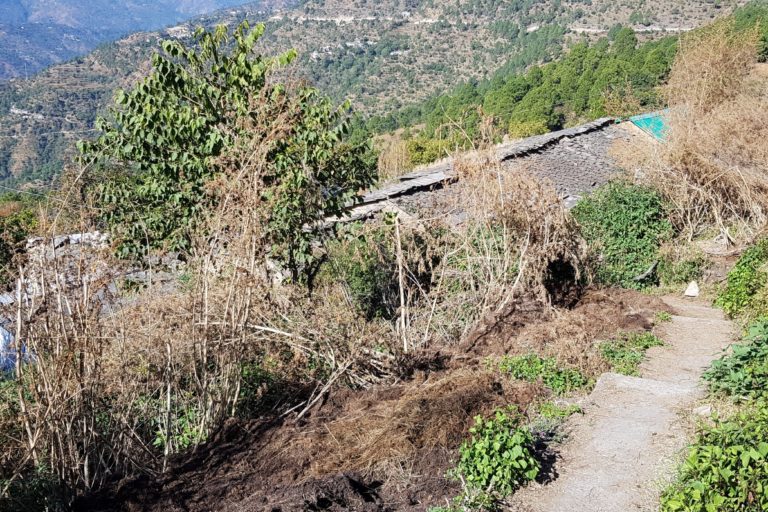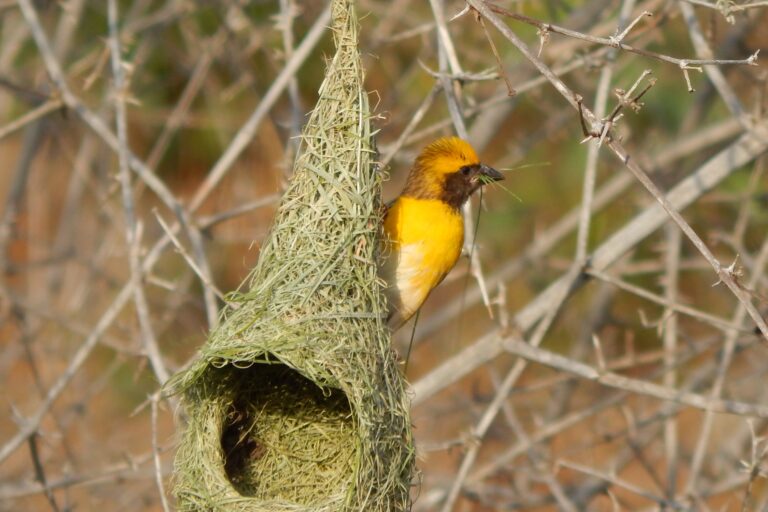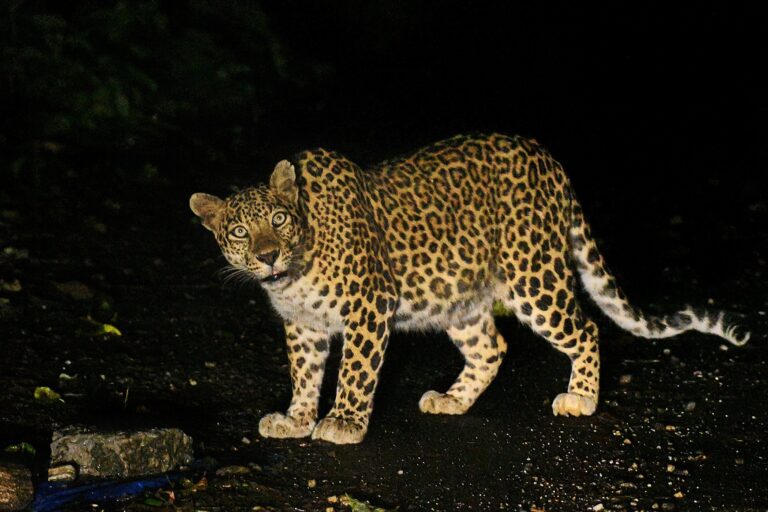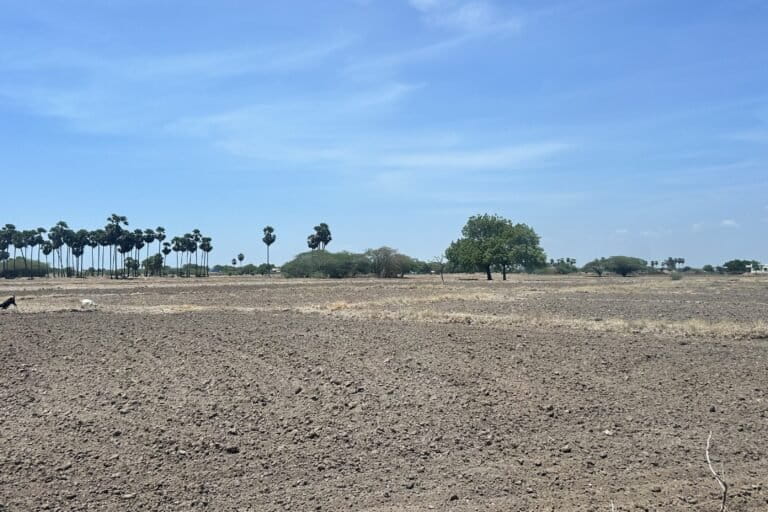- Tales of man-eating leopards have dominated the landscape of Uttarakhand since the days of Jim Corbett in the 1900s, whose 145th birth anniversary is on July 25.
- Leopards are not only facing a loss of habitat but also the lack of prey availability and poaching. The increase in the number of tigers in the state has also forced them to move up the hills where human-animal interactions have increased.
- In the last one decade in Uttarakhand, more than 300 humans have been killed and 2,000 injured in human-wildlife interactions.
- A school teacher, who is popularly known as ‘Corbett of Chamoli’, is educating the hill residents how to coexist with wild animals.
Almost a hundred years ago, conservationist Jim Corbett rescued the people of Rudraprayag in India’s northern state of Uttarakhand, from the terror of a ‘man-eater’ that had claimed at least 125 human lives in the span of just eight years. The tale of this man-eater, that operated along the pilgrim route from Rishikesh to Kedarnath shrine, is documented by Corbett in one of his books – ‘The Man-Eating Leopard of Rudraprayag’. “No curfew order has ever been more strictly enforced, and more implicitly obeyed, than the curfew imposed by the man-eating leopard of Rudraprayag,” wrote Corbett while describing the fear unleashed by the leopard. By the time Corbett eliminated this leopard, its stories were mentioned in the newspapers of India and several other countries including the United Kingdom, Australia, Canada and the United States of America.
On July 25, wildlife enthusiasts and nature lovers celebrate the 145th birth anniversary of conservationist Jim Corbett who protected the village residents of Kumaon and Garhwal regions of Uttarakhand from the wrath of several man-eaters, yet held a very high opinion about the majestic cats that roamed freely and in good number, in the Himalayan jungles. If he called the tiger “a large-hearted gentleman with boundless courage”, he described leopards as “the most beautiful and most graceful of all animals” who according to him was “second to none in courage.”

However today, the leopard isn’t in good shape as its number is dwindling fast due to several natural and human-induced factors. Besides, the number of people killed by leopards is also increasing in the villages of Uttarakhand which creates panic and forces people to migrate out from villages.
Threatened despite adaptability
It is estimated that India has around 12,000-14,000 leopards (commonly called guldaar in hills) all over the country and half of them live in or around the protected forests. There were a total of 703 leopards in Uttarakhand, in 2018. Unlike tigers, leopards are highly adaptive to surroundings. They fall in the ‘Schedule 1 ’ category of India’s Wildlife Protection Act 1972 which means they are among the list of other protected animals like tigers and lions and their illegal killing or poaching invokes equally harsh punishment.
Despite this level of protection, the records of the forest department show that more than 1,200 leopards have been killed in Uttarakhand since it’s formation in November 2000. Experts state that leopards are among the most “endangered” species today.
“Although the leopard is still commonly seen in our surroundings, scientific studies highlight that their number is declining. We have much fewer leopards at the moment. This is despite the fact that leopards can easily adapt to adverse surroundings. While tigers need large protected and disturbance-free forests with abundant availability of big prey like sambar and cheetal (spotted deer) to survive, leopards can live on scavenging around the human habitat. They can feed themselves on anything like poultry waste or even hospital waste,” Bivash Pandav, a senior scientist with the Wildlife Institute of India (WII), told Mongabay-India.
Leopards are facing multiple threats such as loss in habitat, lack of prey availability and poaching for trade. Pandav explains how an increased number of tigers in the protected forests of Terai, has also forced leopards to move up towards north in the hill villages of Uttarakhand where they often face scarcity of prey and it results in conflict with humans.
Data accessed by Mongabay-India show that leopards are responsible for at least half of the human deaths that occur every year in human-wildlife interactions in Uttarakhand. For instance, at least 311 people were killed by wild animals between 2012 and 2019. More than half of them (163) were claimed by leopards alone.
According to Uttarakhand’s forest department, almost 2,000 got injured by wild animals during the same period. This year until June, 18 people had lost their lives in the attacks of wild animals. Among them, leopards were responsible for nine of them.
“The attack on humans (by leopards) is not new. We know through the stories of Corbett that it was happening 100 years ago also but the threat (for the locals) has surely increased today. Migration from hills is certainly one of the reasons responsible for this. As people left the villages for cities, huge grass, shrubs and vegetation grew around the houses, this gave leopard cover to hide … and sometimes they attack humans,” Pandav explained to Mongabay-India.
Read more: Leopards in a spot in Rajasthan
Leopard genes hint at a probable population decline in India a century or two ago
“Corbett of Chamoli”
Fortunately, the people of Uttarakhand have got a few locals among them who not only rescue village residents from the man-eaters but also educate them to deal with this threat. Lakhpat Singh Rawat, 56, a school teacher, who helps the forest departments in catching or ‘eliminating’ the man-eater, is now popularly known as “Corbett of Chamoli.”
Rawat has killed more than 50 man-eaters in the last two decades. “I killed the first man-eater, in March 2002. That was a leopard who had killed 12 children at my school. It had unleashed extreme panic across the villages of Chamoli. Since then I have killed 52 leopards and two tigers who had been declared man-eater by the forest department,” Rawat told Mongabay-India.
Forest officers state that it shooting an animal that has turned into a man-eater is always the last resort. It can be done only after the permission granted by the Chief Wildlife Warden (CWLW) of the state, on the report submitted by the Divisional Forest Officer (DFO) of the affected area. Under the established procedure, first efforts are made to catch the animal alive by laying the trap or tranquilising it.
“In the majority of cases the preventive steps can ensure that there is no loss of human life or injury but it requires awareness, alertness and regulating human behaviours (to avoid human-animal interactions) but in some cases, there is a problem with the leopards and in such cases, they have to be identified and swiftly eliminated,” Rajiv Bhartari, Chairman of Uttarakhand Biodiversity Board and erstwhile Chief Wildlife Warden of the state, told Mongabay-India.

Rawat, who has often been assigned the task to shoot a man-eater several times notes that it is not a job that makes him feel happy.
“I feel a pang of sorrow in my heart. It is always a very painful job to kill such a beautiful and majestic animal who is so important in our food chain. We only are responsible for this situation since we have destroyed the habitat of these wild animals and there is no natural prey left for them in jungles. Where will they go? They are watching humans all around them and attacking when they don’t get anything else to eat,” Rawat said.
Bhartari explains that “careless human behaviour” and “poor waste disposal” have also aggravated the situation.
“Earlier people would observe a safe distance from wild animals but nowadays people take selfies with elephants and other animals using their smartphones. We even see the video of leopards and tigers filmed from a close distance. Another thing is poor waste disposal around human habitation which attracts monkeys and deer. Leopards come close to human habitation stalking these animals and often attack humans who live in the vicinity,” Bhartari emphasised.
How to coexist with wild animals
To make conditions livable there are many steps that can be taken. From educating the locals to sensitising the forest guards to equip the forest department with the right tools and officers. The paucity of veterinary doctors is also one of the problems while dealing with human-animal interactions.
“We have eight veterinary officers but unfortunately, they are confined to only three districts namely Nainital, Haridwar and Dehradun. Therefore, we need veterinary doctors because they are needed to set up rapid rescue teams. The department needs these doctors because only they can certify (in case of attack) that the animal has a problem. They would tell us whether it needs to be taken away or eliminated or just treated and left in the wild,” said Bhartari.
Bhartari also stressed on the need for “radio-collaring” the animals to understand their behaviour. He admits that despite having the equipment in store for a year, not a single leopard has been radio-collared in Uttarakhand so far.
Rawat, on the other hand, studies the behaviour of man-eaters by close observation and experience. He educates the villagers about the traits of man-eaters to avoid the loss of life.
“When a leopard becomes man-eater, he has no fear of humans and becomes very aggressive. A man-eating leopard only comes near the human habitation roughly between 6 to 9 in the evening while the normal leopards who pick the dogs and other animals generally come after 11 in the night. People should not leave the kids or old people unattended after twilight,” he cautioned.

Rawat, who killed a man-eater on July 10, in Narayanbagad village near Rudraprayag, said men, women and children should regulate their lifestyle to protect themselves from leopards.
“There are some very simple things we can do. Like if women go to the jungle to cut grass, they should go in a group of three or four. One the women should always stand as a guard while others are cutting the grass. Leopard will never attack if he knows someone is already watching him,” said Rawat.
Read more: Natural history, religion interweave to help human-leopard coexistence in a Siwalik village
With tigers getting the spotlight, is poaching of leopards increasing in the blind spot?
A tribute to Corbett
After almost 65 years since Jim Corbett died, people like Rawat and his fellow volunteers remember his tales. Locals and government officers acknowledge the role of these volunteers.
“I have known people like Lakhpat Singh Rawat and Joy Hukil (another volunteer) and they act as an amazing institutional memory. What they know and teach us with their vast experience is something that can’t be learned by reading government papers. They are doing a great service,” Bhartari said.
Rawat, who is often called as Corbett of Chamoli for his contribution, said that he feels “happy and proud” when people compare him with Corbett. “But he was a great man. He loved and risked his life for poor paharis (hill residents) with least resources at his disposal. Today we have a telescopic rifle, night vision and lights. He did it without any of this facility. We can only bow our head in his memory,” said Rawat.
Banner image: Uttarakhand has lost more than 1,200 leopards in the last two decades. Photo by Bivash Pandav.













